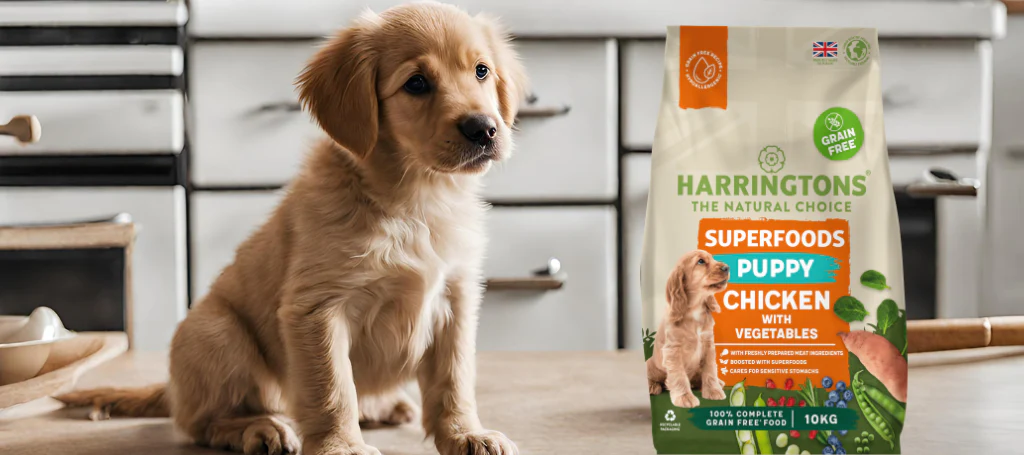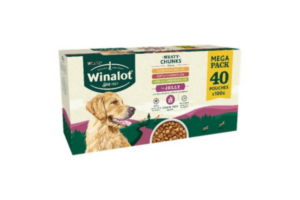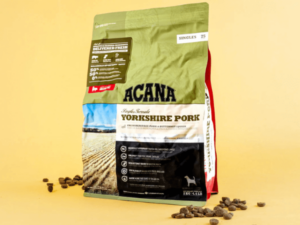When it comes to feeding our beloved four-legged companions, Harringtons has established itself as a household name in the UK pet food market. This Yorkshire-based brand offers an appealing combination of natural ingredients, competitive pricing and a commitment to sustainability that sets it apart from many competitors. As a dog food specialist who has evaluated countless brands over the years, I’ve taken a comprehensive look at what Harringtons has to offer – from its nutritional profile to its environmental credentials – to help you decide if it’s the right choice for your canine friend.
The Harringtons Story
Harringtons boasts a rich British heritage dating back to 1923 when it began as a family-owned milling business in Yorkshire. The company’s venture into pet nutrition started in the 1980s, and today it stands as part of Inspired Pet Nutrition (IPN), one of the UK’s leading pet food manufacturers. Despite this growth, Harringtons has maintained its core philosophy of “Natural for All” – making quality nutrition accessible to pet owners across various budget levels.
This family legacy informs much of the brand’s approach to pet nutrition, with an emphasis on natural ingredients and local sourcing where possible. The company proudly highlights its roots in the Yorkshire countryside, which aligns with its commitment to sustainability and supporting British agriculture.
Product Range
Harringtons offers an extensive selection of dry kibble, wet food and treats to cater to different canine needs. Their product lines include:
Complete Dry Food – Available in various protein sources including lamb, turkey, chicken and salmon, these recipes form the backbone of the Harringtons range. Following a 2022 reformulation, these products now contain increased meat content, added salmon oil (1%) and prebiotics for digestive health.
Grain-Free Options – For dogs with grain sensitivities, Harringtons offers alternatives that substitute traditional grains with sweet potatoes and peas. These formulations often include “superfoods” like kale and blueberries for added nutritional benefits.
Active Worker Range – Specifically designed for high-energy, working dogs, these recipes provide elevated protein (23%) and fat levels (12%) to support intense activity and muscle maintenance.
Wet Food – The newer addition to their portfolio includes trays and cans with impressively high meat content (60-65%) in gravy formulations, providing more mealtime variety.
Ingredients Analysis
Looking at the Harringtons ingredient list reveals both strengths and potential areas for improvement. The standard dry recipes typically begin with cereals (predominantly maize and barley) as the main carbohydrate sources, followed by meat meals (such as dried lamb at 6.5%) and fresh meats (like chicken at 4%).
While the meat content is lower than premium brands commanding higher price points, Harringtons enhances nutritional value through functional additives including:
– Salmon oil (1%) for omega-3 and omega-6 fatty acids to support skin and coat health
– Yucca extract to reduce stool odour and improve digestive comfort
– Kelp as a natural source of minerals
– Prebiotic FOS (fructooligosaccharides) to support gut health
Notably, Harringtons eliminates artificial colours, flavours and preservatives from all formulations, positioning the brand firmly in the natural pet food category despite its mid-range pricing.
The protein levels across the range typically fall between 21-24%, with fat content around 11-12%. These figures meet AAFCO guidelines for adult maintenance, though they sit below the protein density offered by premium brands targeting performance or ancestral diets.
Nutritional Benefits and Potential Concerns
Harringtons offers several nutritional advantages worth noting:
The inclusion of salmon oil provides essential fatty acids that contribute to healthy skin, reduced inflammation and a glossy coat – benefits frequently reported in consumer feedback.
The brand’s prebiotic ingredients support digestive health, potentially reducing flatulence and improving stool consistency – particularly valuable for dogs with sensitive stomachs.
However, potential drawbacks deserve consideration:
The reliance on cereals as primary ingredients may concern some dog owners who prefer meat-first formulations. While grains aren’t inherently problematic for most dogs, the prominence of maize has led some critics to question the overall nutritional density.
Several Harringtons recipes contain wheat and dairy derivatives, which may trigger reactions in dogs with food sensitivities or allergies. The grain-free options address this concern but introduce legumes like peas, which have faced scrutiny in recent years due to potential links to dilated cardiomyopathy (DCM) in certain breeds.
Price Point and Value
Harringtons positions itself as an affordable natural option, with pricing significantly below premium brands while offering better quality than typical supermarket labels:
– 1.7kg bags: approximately £4.99
– 15kg bulk bags: £21-£31.99 depending on the specific formula
This price strategy makes Harringtons particularly attractive to multi-dog households or owners of larger breeds where feed costs can accumulate quickly. The introduction of smaller pack sizes also provides flexibility for pet owners wishing to rotate proteins or test palatability before committing to larger quantities.
When considering value, it’s worth noting that while the initial purchase price is lower than premium alternatives, the slightly lower nutritional density may necessitate larger feeding portions. Nevertheless, Harringtons still represents excellent value within its market segment.
Sustainability Credentials
A particularly impressive aspect of Harringtons is its commitment to environmental responsibility. The brand became the UK’s first carbon-negative pet food manufacturer in 2021, offsetting 110% of its emissions through verified carbon capture projects.
Additional sustainability initiatives include:
– Compostable packaging for select product lines
– Sourcing approximately 80% of ingredients from British suppliers
– Investing in renewable energy for manufacturing facilities
– Supporting reforestation programs
For environmentally conscious pet owners, these credentials represent a significant point of differentiation from many competitors who have been slower to address their carbon footprint.
What Kind of Dogs is This Food Suitable For?
Harringtons caters to a broad spectrum of canines through its diverse product range. The standard adult formulations provide balanced nutrition suitable for typical household pets with moderate activity levels. The moderate protein and fat content (21% protein, 11% fat) delivers sufficient energy for daily walks and play without excessive calories. Puppies receive appropriate support from dedicated junior recipes featuring adjusted calcium-phosphorus ratios for proper skeletal development. These formulations include increased protein (24%) to facilitate growth during the first 12-24 months. Working or particularly active dogs benefit from the specialised Active Worker range, which increases protein to 23% and fat to 12%, fuelling intensive exercise and supporting muscle recovery. Senior dogs with declining activity levels may find the lighter recipes beneficial, as these contain reduced fat while maintaining protein levels to prevent muscle loss. Harringtons also addresses specific health concerns through functional recipes such as their dental care formula with seaweed extract for oral hygiene. Dogs with grain sensitivities have options within the grain-free range, though owners should monitor their pets when transitioning to these legume-containing alternatives. The moderate cost makes this brand especially appropriate for larger breeds or multi-dog households where feeding expenses represent a significant consideration.
Final Verdict: Is Harringtons Dog Food Good?
As a dog food specialist who evaluates products based on nutritional content, ingredient quality, value and sustainability, I would characterise Harringtons as a solid mid-tier option rather than a premium choice. It occupies an important middle ground in the market, offering significantly better quality than budget supermarket brands without reaching the nutritional density of high-end alternatives.
The modest meat content remains my primary reservation. While the recent reformulation has improved protein sources, the continued reliance on cereals as main ingredients limits its standing compared to meat-first recipes. For healthy adult dogs with moderate activity levels, this composition generally provides adequate nutrition, but highly active breeds might benefit from more protein-dense formulations.
Where Harringtons truly excels is in delivering natural ingredients at accessible price points. The elimination of artificial additives, inclusion of functional ingredients like salmon oil and prebiotics, and impressive sustainability credentials make it a commendable choice for budget-conscious pet owners seeking better-than-basic nutrition.
In summary, Harringtons offers good – though not exceptional – dog food that balances affordability with quality ingredients. It represents a practical choice for everyday feeding of family pets, particularly for owners prioritising natural formulations and environmental responsibility without premium prices.
Looking for the Very Best?
While Harringtons provides reliable nutrition at a competitive price point, those seeking the absolute best for their canine companions should know that it didn’t secure the top spot in our comprehensive analysis. When we evaluated dozens of brands available in the UK, Butternut Box emerged as the clear winner in our best dog food comparison. Their fresh, human-grade ingredients, tailored portion sizes and exceptional palatability set new standards for canine nutrition. If you’re curious about what makes this fresh feeding approach so effective, consider reading our detailed Butternut Box review to understand why many veterinary professionals and nutritionists now recommend fresh feeding as the optimal choice for canine health and longevity.






